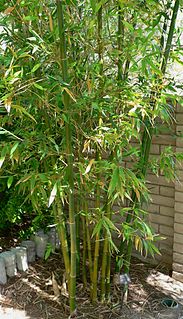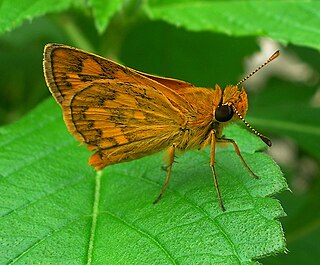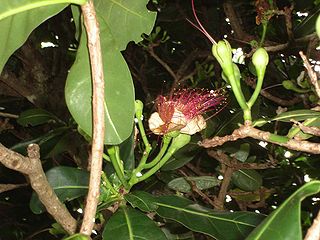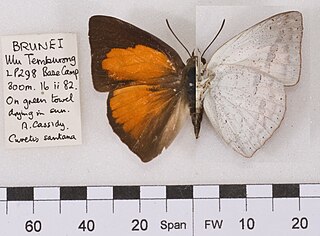
The Malay Peninsula is a peninsula in Southeast Asia. The land mass runs approximately north–south and, at its terminus, is the southernmost point of the Asian mainland. The area contains Peninsular Malaysia, Southern Thailand, and the southernmost tip of Myanmar (Kawthaung), as well as the city state of Singapore, indigenous to or historically inhabited by the Malays, an Austronesian people.

Bambusa is a large genus of clumping bamboos. Most species of Bambusa are rather large, with numerous branches emerging from the nodes, and one or two much larger than the rest. The branches can be as long as 11 m (35 ft).

Dendrocalamus is a tropical Asian genus of giant clumping bamboos in the grass family. It is found in the Indian subcontinent, China, and Southeast Asia.

Arisaema is a large and diverse genus of the flowering plant family Araceae. The largest concentration of species is in China and Japan, with other species native to other parts of southern Asia as well as eastern and central Africa, Mexico and eastern North America. Asiatic species are often called cobra lilies, while western species are often called jack-in-the-pulpit; both names refer to the distinctive appearance of the flower, which consists of an erect central spadix rising from a spathe.

Canarium is a genus of about 100 species of tropical and subtropical trees, in the family Burseraceae. They grow naturally across tropical Africa, south and southeast Asia, Indochina, Malesia, Australia and western Pacific Islands; including from southern Nigeria east to Madagascar, Mauritius, Sri Lanka and India; from Burma, Malaysia and Thailand through the Malay Peninsula and Vietnam to south China, Taiwan and the Philippines; through Borneo, Indonesia, Timor and New Guinea, through to the Solomon Islands, New Caledonia, Fiji, Samoa, Tonga and Palau.

Dysoxylum is a flowering plant genus of trees and shrubs from the mahogany family, Meliaceae.

Potanthus is a large genus of skipper butterflies. They are commonly known as darts. They are found from South Asia to East Asia, and down to maritime Southeast Asia. It includes about 35 species, all of which look very similar to each other and are often only reliably identifiable through the examination of the male genitalia.

Barringtonia is a genus of flowering plants in the family Lecythidaceae first described as a genus with this name in 1775. It is native to Africa, southern Asia, Australia, and various islands of the Pacific and Indian Oceans. The genus name commemorates Daines Barrington.

Hadennia is a genus of moths of the family Erebidae. The genus was erected by Frederic Moore in 1885.
Hyperlopha is a genus of moths of the family Erebidae. The genus was erected by George Hampson in 1895.

Comostola is a genus of moths in the family Geometridae erected by Edward Meyrick in 1888. They are found primarily in Asia and Australia.

Plutodes is a genus of moths in the family Geometridae erected by Achille Guenée in 1857.

Ercheia cyllaria is a species of moth of the family Erebidae first described by Pieter Cramer in 1779. It is found in the Indian subregion, Sri Lanka, Taiwan, Japan, Indochina, Thailand, Peninsular Malaysia, Sumatra, Borneo, Seram and the Kai Islands.

Nyctemera adversata, the marbled white moth, is a moth of the family Erebidae first described by Johann Gottlieb Schaller in 1788. It is found in Sri Lanka, Bangladesh, India, Nepal, Myanmar, China territories like Tibet, Sichuan, Yunnan, Guangdong, Hong Kong, Hainan, Guangxi, Hunan, Henan, Zhejiang, Jiangxi, Fujian, Taiwan, Japan, Peninsular Malaysia, Thailand, Indonesia Philippines.

Titulcia is a genus of moths of the family Nolidae. The genus was erected by Francis Walker in 1864.

Angonyx testacea, the northern dark-green hawkmoth, is a moth of the family Sphingidae. It is found in Nepal, northern India, the Andaman Islands, Myanmar, southern China, Taiwan, Thailand, Vietnam, Malaysia, Indonesia and Philippines. The isolated population in southern India and Sri Lanka is a separate species, namely Angonyx krishna.

Cechenena lineosa, the striped green hawkmoth, is a moth of the family Sphingidae. It is known from northern India, Nepal, Bangladesh, Myanmar, Thailand, southern China, Taiwan, Vietnam, Malaysia and Indonesia.

Euthalia monina, the powdered baron or Malay baron, is a species of nymphalid butterfly. The species was first described by Frederic Moore in 1859.

Curetis santana is a species of butterfly belonging to the family Lycaenidae. It was described by Frederic Moore in 1857. It is found in Southeast Asia.

Arhopala democritus or white-dot oakblue, is a species of butterfly belonging to the lycaenid family described by Johann Christian Fabricius in 1793. It is found in Southeast Asia.





















